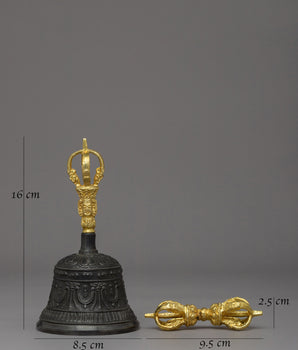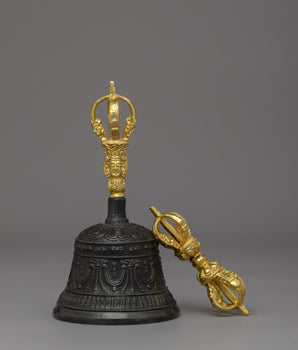Empower Your Life with Goddess Vasudhara's Blessings of Wealth
Hailed for her bountiful bestowals, Vasudhara Goddess descended from the heavens with a singular purpose: to grace the Earth with opulence and affluence. Her name, Vasudhara, derived from Sanskrit, elegantly translates to "stream of gems" or "earthly wealth" in English. In Buddhist folklore, she stands as the divine partner of Jambhala (also known as Dzambhala), the revered deity of riches.
The deity is revered as the bodhisattva of fertility, wealth, prosperity, and abundance. She bestows her devotees with a dual benefaction: tangible riches and spiritual abundance. Much like her fellow Mahayana goddesses, her essence resonates with compassion and benevolence, extending to all living beings.
She encapsulates the spirit of boundless generosity (dana), the foremost among the Six Transcendental Perfections (referred to as Skt. paramitas), which form the bedrock of the Bodhisattva journey. Rooted in the Buddhist tradition, Vasudhara possesses the mystical capability to materialize wealth through reciting her mantra and observing rituals that beckon her divine presence.
Recognized as 'Norgyunma' in Tibetan culture, the goddess Vasudhara emerges as a deeply revered bodhisattva within Buddhism, embodying the essence of affluence, prosperity, and opulence. She is equally acknowledged as the 'Golden Tara' or 'Yellow Tara,' adding to her multifaceted reverence.
Depiction of the Vasudhara Devi
Click here to buy our Hand Painted Vasudhara Thangka
Within Indian Buddhist art, the goddess Vasudhara is often portrayed in a radiant yellow hue, symbolizing wealth, fertility, and the luminance of spiritual vitality. She is typically depicted with a serene countenance and presents herself with a single visage and dual hands. Her right hand assumes the varada mudra, a gesture symbolic of generosity, occasionally clasping a gemstone or bilva fruit, both signifying affluence. In her left hand, she cradles a stem adorned with grains, connoting the concept of abundant harvest and prosperity.
In some portrayals, her left hand upholds a vessel containing seeds and precious gems or a lotus upon which the vessel is poised—her form alternates between standing and sitting postures (padmasana or lalitasana). In the latter pose, her right foot rests upon a vessel brimming with riches or lotuses. Alternately, she is portrayed with four hands – two bearing a gemstone and a vessel of plenty, while the remaining two execute the varada and abhaya mudras, representing the fearlessness gesture.
Goddess Vasudhara is frequently portrayed with two to six limbs. This multi-limbed image represents her heavenly power to perform several jobs at once and grant gifts in a variety of forms.
She has been portrayed with numerous faces, each of which is looking in a different direction. This symbolizes her capacity to keep an eye on and bestow benefits on all beings, wherever they may be. It highlights her all-encompassing character and compassion for all people.
Legends and Tales of Vasundhara
The Inquiry of the Layman Sucandra
The inception of Vasudhara within Buddhism finds its roots in the Buddhist scripture known as "The Vasudhara Dharani." A legendary account recounted in the exact text portrays "The Inquiry of the Layman Sucandra." In this narrative, a destitute layman named Sucandra approached Buddha Shakyamuni, seeking a means to acquire substantial quantities of gold, grain, silver, and precious gems.
He aimed to provide for his large family and further engage in charitable endeavors with the surplus wealth. In response, Buddha Shakyamuni bestowed upon him the Vasudhara mantra and a sacred rite. When faithfully practiced, this combination would invoke Vasudhara herself, ushering in good fortune and affluence.
His prosperity flourished as Sucandra embarked on the rituals and imparted their wisdom to others. Witnessing his rapid success, the monk Ananda inquired from Shakyamuni about the source of his newfound fortune. In turn, Shakyamuni advised Ananda also to practice the Vasudhara mantra and ritual, urging him to "share it among many" for the collective benefit.
Click here to buy our Gold Statue Of Goddess Vasudhara
Legends from Taranatha
Tales recounted by Taranatha, a distinguished Tibetan monk and scholar, reveal further narratives highlighting Vasudhara's boundless generosity. In these chronicles, Taranatha illustrates that the bodhisattva Vasudhara bestowed upon the monk Buddhajnana a remarkable gift of three hundred pearl necklaces daily.
This boon was accompanied by a steady influx of buyers seeking these adornments. With this newfound prosperity, Buddhajnana channeled his fortune into the betterment of the monastery. He supported fellow monks and students, procured votive statues and ceremonial items, and contributed substantial donations to the monastery's coffers. His charitable endeavors, driven by his refusal to amass personal wealth, resulted in Vasudhara's continued bestowal of gifts throughout his life.
Parallels between Vasudhara and Lakshmi
She is believed to have originated within Indian Buddhism and later her influence traversed Tibet. In the Indian context, Vasudhara finds resonance with Lakshmi, the Hindu deity associated with wealth, fortune, and opulence.
The parallels between Vasudhara and the Hindu goddess Lakshmi are frequently drawn. Both revered as bestowers of wealth, these divine figures share a strikingly analogous iconography and are revered for their roles in fostering abundance in harvests. In artistic portrayals, both don a radiant golden hue and adopt similar hand gestures (mudras) while clutching comparable attributes.
A case in point is the imagery of both Vasudhara and Lakshmi holding precious gems or standing atop vessels brimming with treasures. It's believed that the convention of representing Vasudhara standing upon vases originated from earlier depictions of Lakshmi. Additionally, both goddesses are often depicted in tandem with their respective partners – Lakshmi found alongside Vishnu, and Vasudhara, partnered with Jambhala.
Vasudhara Mantra Practice & Benefits
"Om Śri Vasudhara Ratna Nidhana Kashetri Soha"
Aligned with wealth, prosperity, and abundance, Vasudhara is known to shower conscientiously earned riches upon her devotees, harmonizing spiritual insight with favorable life conditions, encompassing elevated living standards, extended longevity, and profound happiness.
Those who recite her mantra and engage in rituals invoking her presence benefit from her mystical capacity to manifest wealth. This prompts devotees to fervently offer prayers and perform rituals, seeking her blessings for the augmentation of prosperity and affluence.
Embarking on the practice of the goddess demands unwavering dedication and steadfast discipline. Foundational in this practice is firmly establishing your intention, inscribing it in writing before engaging with the mantra. As you immerse yourself in the recitation of the mantra, infuse it with the essence of your intention, dedicating this practice to the sincere pursuit of your desired aspirations. The chanting of the Vasudhara mantra is upheld to yield abundance and favor, ushering in favorable fortune for the devoted practitioner.







